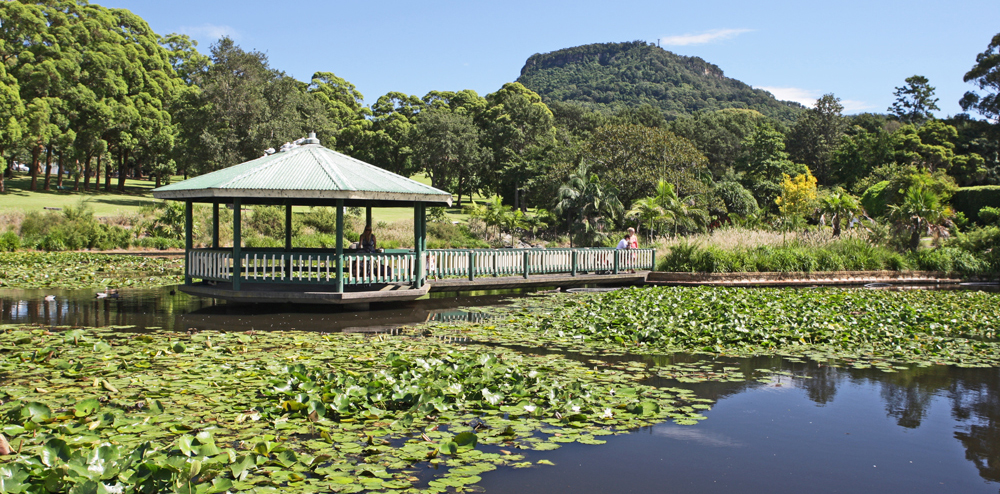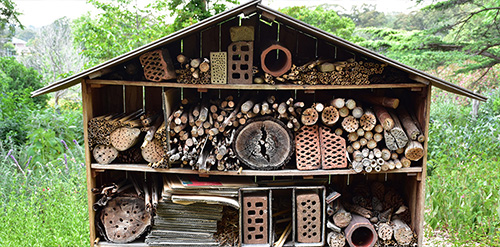Living collections
Call us biased, but we think the best parts of the Botanic Garden are our Garden Collections.
Built features
While you are exploring, keep an eye out for some of these interesting built features:
Our All Abilities Playground makes a visit to the Botanic Garden extra fun for 2 – 12 year olds! Carers should provide supervision for small children at all times.
Located near our Murphys Avenue entrance, this space includes swings, a sandpit, slippery dip, climbing net, viewing platform and a maze.
Set on the slope below Gleniffer Brae within the Rainforest Collection, our amphitheatre is a unique setting for theatre, music or other performances. It features a wooden stage, and surrounding embankment, circled by trees.
Feel free to stage your own non-amplified jams or rehearsal sessions!

The Duck Pond provides a relaxing setting near our main entrance on Murphy’s Avenue. The stunning rotunda in the middle of the pond is a favourite spot for wedding photos.
Keep an eye out for the native ducks, or even the eels who call this pond home. If you feed the ducks, please avoid giving them bread as this can make them sick. Instead, go for healthier options like green peas, grapes cut in half, or duck feed pellets.
REMEMBER: please only feed the ducks a very small amount - we ask only 10 peas per person (better still, don't feed them at all, they have plenty of natural food available to them). We have so many visitors, which means the ducks are getting quite sick from too much food, and sadly some have had to visit the vet with critical health issues and be removed from the Garden.
We have two Garden Library Bookcases with a range of fiction, non-fiction and children’s books for all to read.
Locations:
- Next to the Cafe at the Murphys Avenue entrance
- Along the main path to the north west of our Flowering Trees and Shrubs collection.
You are welcome to borrow a book, keep a book, or leave a book for others to enjoy. Donations are welcome.
This initiative is brought to you by the Friends of Wollongong Botanic Garden in partnership with Wollongong City Libraries.

Our gardens are home to a wide range of living creatures. Insect hotels provide our local insects a place of sheltered sanctuary in winter, as well as a nesting space in summer. You will spot a few of these around the garden, with the largest one located along the main path at the north-eastern side of our Flowering Trees and Shrubs collection.
It is estimated that the average backyard garden attracts more than 2,000 insect species at any given time, including bees, beetles, wasps and butterflies. Many of these important visitors play a crucial role in pollinating flowers - an important task considering about a third of our food supply depends on pollination.
These beneficial creatures can reduce or eliminate the need for pesticides. They also play an important role in supporting biodiversity, which in turn helps increase the productivity of our ecosystem.
How to build your own insect hotel
Make use of natural and recycled materials that are non-toxic.
Materials
- A wooden box that is at least 20cm deep
- Small wood blocks, clay bricks, logs and/or twigs like bamboo, or even old Banksia fruit.
Steps
- Open one side of the wooden box
- Create a sloping roof on one side of the box to deflect the rain
- Drill small angled holes in the blocks or logs varying from 3mm to 10mm - the light angle will ensure any moisture can run out
- Place the blocks or logs within the box
- Locate a sheltered spot within your garden that gets morning sun exposure
- Position the insect hotel in your chosen spot, with the opening facing the sun.
The traditional Japanese bridge (pictured at the top of this page) and tea house were presented as a gift to the City of Wollongong from the City of Kawasaki in 1993 to mark the fifth anniversary of our Sister City relationship.
The shape of the bridge is called taiko-bashi (drum bridge) in Japanese. Look into the water from the top of the bridge over Middle Creek, and you’ll see its reflection form the circular shape of a drum.
The Kawasaki Bridge and Japanese Tea House are a short distance from the Duck Pond.
Access to the Bridge is not currently possible while repairs are undertaken.
The Garden is a healing place. To help you connect to nature we've installed the 'Go Slow for a Mo' wellness trail , designed to help you improve your general wellbeing. Come, slow down and spend more meaningful time in nature.
The trail starts at the south west corner of the Turpentine Lawn with seven short sensory exercises along the way. You can choose to just do one, a few or all exercises. It’s totally up to you! Check out the trail online, or look out for the signs when you visit.
Sculpture in the Garden
In 2016, this biennial Acquisitive Sculpture Award commenced at Wollongong Botanic Garden. During your visit, check out the winners on permanent exhibition:
- King Coal by Louis Pratt (2016 Winner): located in our Flowering Trees and Shrubs collection
- Steel City by Michael Purdy (2018 Winner): located on the Duck Pond Lawn, near the Kawasaki Bridge
- Curious Dream of an Architect by Fatih Semiz (2021* Winner): located on the lawn in front of the Japanese Tea House
* The 2020 Sculpture in the Garden event was postponed due to the coronavirus (COVID-19) pandemic.
For more information, see the Sculpture in the Garden page.
The Mercury Fountain
Designed by Robert Woodward, the Mercury Fountain was inspired by Wollongong’s industrial and mining history, and the five islands off our coastline.
The Mercury Fountain started its life in the centre of Wollongong. Presented to the city by The Illawarra Mercury to mark the newspaper’s 125th anniversary in 1980, the fountain was first installed in Rest Park, between Burelli and Crown Streets.
A short time later, Rest Park was flagged for removal to make way for Wollongong’s developing shopping area. In 1984, the fountain was relocated to its present site at the Botanic Garden.
Facilities
- Carparks (Free): 2hr parking limit
- Access for people with disability
- Parents' room
- Picnic areas
- Barbeques (Free)
- Pani Cafe - in addition to coffees, teas and hot chocolates, you’ll can pick up some delicious muffins, croissants, pies, quiche, spinach triangles, bureks and toasties between 9am and 2pm weekdays and 9am to 4pm weekends.
- Playground
- Public toilets
- Spaces and venues for hire for weddings, celebrations and parties or community events.

